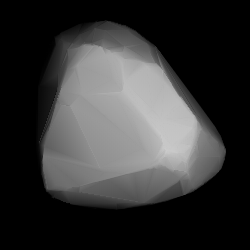Astronomy:287 Nephthys
From HandWiki
Short description: Main-belt asteroid
 Modelled shape of Nephthys from its lightcurve | |
| Discovery | |
|---|---|
| Discovered by | C. H. F. Peters |
| Discovery date | 25 August 1889 |
| Designations | |
| (287) Nephthys | |
| Pronunciation | /ˈnɛfθɪs/[1] |
| Named after | Nephthys |
| A889 PB | |
| Minor planet category | Main belt |
| Orbital characteristics[2] | |
| Epoch 31 July 2016 (JD 2457600.5) | |
| Uncertainty parameter 0 | |
| Observation arc | 119.35 yr (43594 d) |
| |{{{apsis}}}|helion}} | 2.4080 astronomical unit|AU (360.23 Gm) |
| |{{{apsis}}}|helion}} | 2.29814 AU (343.797 Gm) |
| 2.3531 AU (352.02 Gm) | |
| Eccentricity | 0.023344 |
| Orbital period | 3.61 yr (1318.4 d) |
| Mean anomaly | 125.74° |
| Mean motion | 0° 16m 23.016s / day |
| Inclination | 10.034° |
| Longitude of ascending node | 142.381° |
| |{{{apsis}}}|helion}} | 2022-Jul-13 |
| 121.02° | |
| Physical characteristics | |
| Dimensions | 67.60±1.4 km |
| Rotation period | 7.605 h (0.3169 d) |
| Geometric albedo | 0.1851±0.008 |
| S | |
| Absolute magnitude (H) | 8.30,[2] 8.26[3] |
Nephthys (minor planet designation: 287 Nephthys) is a large Main belt asteroid that was discovered by German-American astronomer C. H. F. Peters on August 25, 1889, in Clinton, New York and named after the goddess, Nephthys in Egyptian mythology.[4] It is classified as an S-type asteroid.
References
- ↑ Noah Webster (1884) A Practical Dictionary of the English Language
- ↑ 2.0 2.1 Yeomans, Donald K., "287 Nephthys", JPL Small-Body Database Browser (NASA Jet Propulsion Laboratory), https://ssd.jpl.nasa.gov/sbdb.cgi?sstr=287, retrieved 11 May 2016.
- ↑ Warner, Brian D. (December 2007), "Initial Results of a Dedicated H-G Project", The Minor Planet Bulletin 34: pp. 113–119, Bibcode: 2007MPBu...34..113W.
- ↑ Schmadel, Lutz D. (2012), Dictionary of Minor Planet Names, Springer, p. 38, ISBN 3642297188, https://cds.cern.ch/record/1339660/files/978-3-540-29925-7_BookTOC.pdf
External links
- 287 Nephthys at AstDyS-2, Asteroids—Dynamic Site
- 287 Nephthys at the JPL Small-Body Database
 |

